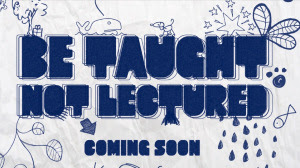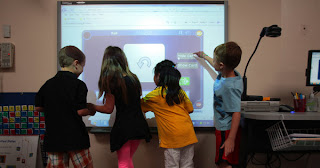
With today's technology, there are so many available tools to help enhance teachers' classrooms. I watched the video
Assistive Technologies for Vision and Hearing Impaired Children. In this video many tools are shown that can help increase the learning experience for impaired children. A few of these are sensory aids, flip cameras, text telephones and text to speech devices. Sensory aids, such as hearing aids, can allow students with hearing impairments to hear better in the classroom, thus automatically increasing the things they can learn. Flip cameras allow access to videos immediately. Text telephones are used for those who have speech impairments. The main tool that struck my attention most was the text to speech devices. These are frequently used for students who have ALS. There are apps you can download on the iPad such as EZSpeech Pro, Fat Cat Chat Repair and Verbally Premium. EZSpeech Pro is for literate users who have lost their speaking ability to ALS. Users can receive phrases from others and store them in their device. The Fat Cat Chat Repair is more "small talk" based. The student can push a symbol, then they are prompted to choose from fifteen different words choices that best fit the symbol. Verbally Premium seems like it would be extremely helpful for those who are speech impaired. With this app, students can save their favorite phrases or most commonly used phrases. The voice can be personalized. Students often use this for common places such as a doctor's office or the classroom. These apps, along with many others, can be found on a
Special Apps, Special Kids blog.
The other video I watched was the
Mountbatten video. The Mountbatten is a braille writing machine. You can connect it to a computer and save, transfer, and receive files. It helps recognize braille characters, allows play for young children who are not physically able to use traditional braille writers, provides basic level concepts of using braille and displays the children's work. This is a great way for impaired children to be included in classroom activities such as peer group projects.
It's hard to say which of these I will use in my classroom, but I think all are potential tools that could help me with any impaired students I may have. Hopefully I will have an iPad in my classroom, in which case I could download any of these apps to use in my classroom. I think it is so important that project based learning is including impaired children. All children deserve the opportunity to explore and learn at their full potential. They can't do this without teachers who are willing to let it happen!
 Jamie Risner What Assistive Technologies Are Available To You As A Teacher ?
Jamie Risner What Assistive Technologies Are Available To You As A Teacher ? Teaching Math To The Blind
Before watching this video, I never gave much thought to how a blind student learns math. I had always assumed blind students learned math with braille. However, blind students are unable to learn math using braille because braille is only linear and cannot show two diminutions in math problems. Professor Art Karshmer at the University of San Francisco, designed a solution to this problem. Professor Karshmer put braille on small blocks that look like scrabble pieces and then designed a board that was made into a grid. The blind students scan a block and then put it on the board. The computer then tells them in what row and grid they placed the block in. This design makes it possible for blind students to work problems out in two diminutions, which helps give blind students a foundation of math. This design is one of the most important tools available to blind students and the teachers responsible for teaching them math. Without a foundation of math, the number of jobs for a blind person becomes more limited.
Ipad Usage For The Blind
This video was amazing! Wesley Majerus is blind, yet in this video he demonstrates how new software that is put into an iPad makes it possible for a blind person to use an iPad. The software has voice-over which allows the user to drag their finger over the screen while the iPad tells them which app their finger is on. Another great feature this iPad offers is a main stream e-reader. By having e-readers available, a blind person can buy a book they would like to read but which is too expensive or else not offered in braille. The e-reader on the iPad reads the books out loud and describes images in the book. The only problem with the e-reader that I noticed during the video was that the reading voice was fast and hard to understand at times. The best thing about this iPad is that it comes this way out of the box and already set up. This makes it more user friendly to its blind owner. With this new software, a blind person is now able to use the same type of technology that seeing people can.
New And Useful Technology For The Blind
I was amazed at all the different technology for the blind. I found two different ones on the website www.ehow.com click here ; that I thought would be very helpful. The first technology is called the smart cane. The smart cane is a new and better version of the walking stick. The smart cane can detect objects around the user up to a few meters away. This would be a great thing for a blind student to be able to have for crowed hallways or field trips. The most impressive technology for a blind person on this website was the Knfbreader mobile. The knfbreader mobile is a phone for a blind person; however it also has a camera that lets the owner take pictures of a text. The knfbreader mobile will then read that text back to them. This would be an amazing tool for a blind person in any situation in which braille text is not available. However, I was unhappy to find that I would not be able to use these tools in my classroom because they are hard to obtain and very expensive.
Maggie Adkisson What assistive technologies are available to you as a teacher? In Teaching Mom What Her Deaf/Blind Child Is Learning On the iPad, I was able to watch as a parent was given instructions to use an iPad, that her child uses in class. It was simply amazing to watch. Although, it was just an iPad that so many people use day to day, I have never seen it used in such a way, nor did I realize what an incredible tool it really is to have. The parent was able to slide her finger across the top of the screen while the iPad read aloud to her the apps available to select. When she found the app she was instructed to find, she was able to double click anywhere on the screen to bring it up. Even more amazing she was able to type any letter by using this speaking iPad to help select the proper letters.
After watching this video I wondered who was this Denise Robinson? I google searched "Denise Robinson special ed teacher" and the seventh listing was the article, A New Model of Education for Blind and Low Vision Students. As it turns out she has an amazing story of her own. It is not just Denise Robinson, but Dr. Denise Robinson. A woman who puts every waking minute into working with blind children. Her inspiration? She lost her vision due to diabetes when she was twenty-four. Fortunately, she gained her sight back years later due to several surgeries. Through her experience of being blind, she understood the improvements needed to help others be able to function and live a normal life. Her story is inspirational and reminds me of my math class last semester where I encountered a boy that was blind. I had never been around someone who was blind and for me it was fascinating. He was so smart and I could not understand how he was able to survive in college. I remember talking to my mom about him. Saying that, even though I did not know him very well I was so proud of him because if it was me, I don't think I would be able to go and do what he is accomplishing. Likewise in the article, she tells that there is a 74 percent unemployment rate among blind individuals because they are not being taught effectively. With her methods and use of technology she is working miracles in lives of so many students. She is someone that I inspire to be like. This video and research is useful to me because it made me realize how much I would enjoy making a difference like Dr. Robinson has working with blind children. After this assignment I will definitely be looking into specializing my education to help the blind.
The article, 50 Must-See Blogs For Special Education by Jeff Dunn, is a great resource for teachers. It has different blogs that cover anything and everything. From special education tips and strategies all the way to blogs for specific disorders. One particular blog that caught my attention was, ADDitude Blogs, a blog made to help those dealing with attention deficit. It is a brilliant website. Not only is it available to help those coping with the disorders, but the writings are all from those suffering from ADD, parents whose children have been diagnosed, as well as ADHD experts. For a teacher, this is a great because the writings are not giving a glossed over, dictionary version of a disorder. It is giving you personal accounts, findings, methods all from people who understand. When you have a child in your class that has a disorder such as ADD or ADHD, what would you rather read to be able to help them to the best of your ability, a research paper or a personal account?












